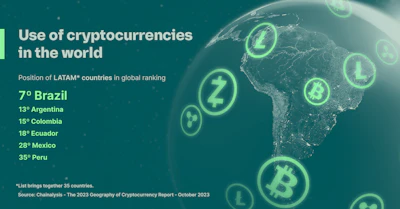Didn’t find what you were looking for?
Select your institution type:
Date: 26/03/2024
Latin America and the Caribbean are at the forefront of digital money adoption globally, according to the International Monetary Fund (IMF).
This scenario reflects government initiatives that favor automation and digitization across various sectors of the economy through blockchain.
Currently, at least 12 jurisdictions already have some form of regulatory framework that allows not only the development of Central Bank Digital Currency (CBDC) projects but also the evolution of cryptocurrencies and stablecoins.
The LATAM blockchain market reached US$800 million in 2023. It is expected to grow by 54% annually, reaching US$39.7 billion by 2032, according to projections by EMR-Claight.
Brazil is among the most advanced countries in the region in developing this technology by promoting the Drex (Real Digital) project. In the coming months, the Brazilian Central Bank will develop proofs of concept to enhance the network's scalability and privacy, with Parfin being one of the companies testing the privacy solution.
With the Lei das Criptos (Crypto Law, 14.478/22) regulation underway, the sector is also advancing in Brazil. Today, 7.4% of the population trades crypto assets, with stablecoins taking the lead as the most traded asset (95% of the volume, according to data from the Federal Revenue). The country ranks 7th in the LATAM cryptocurrency usage ranking by Chainalysis.

Brazil’s neighbor ranks second in global crypto usage. The sector gained adopters amid challenging economic conditions characterized by high inflation and recession. It is estimated that 5.2% of the population uses bitcoins and especially stablecoins to preserve the purchasing power of money and as a means of payment in the real economy.
It is no coincidence that Argentina is among the top countries in the world that pay salaries in cryptocurrencies. Current legislation allows workers to receive up to 20% of their income in digital assets.
Tokenization initiatives are also advancing in Argentina, enabled by the regulatory sandbox in place since 2022. In recent years, the government has been striving to create an environment that is more favorable and able to retain and attract more entrepreneurs from this segment. The market is expected to contribute to the recovery of some economic sectors.
Looking at LATAM as a whole, the Bahamas stands out as a pioneer in adopting a CBDC, the Sand Dollar, in 2020. Jamaica and the Eastern Caribbean Currency Union (ECCU) followed the same path.
"The crypto industry is expected to grow exponentially in the region through real-economy usage, especially of stablecoins. It's a way to democratize access to dollars for the population," says Cristian Bohn, co-founder and CSO of Parfin.
Tokenization should be driven by advances in regulations and the execution of CBDC projects, which are already underway. "With central bank digital currencies in circulation, financial institutions will accelerate the tokenization of other assets and create decentralized financial services," says Bohn.
The world is moving towards tokenization. Reach out to learn how Parfin can guide your company's digital asset journey!
Request a demo
Select your institution type: